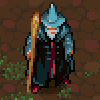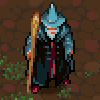Where do the hours go? A Post-Mortem of “i need to lie down” for Ludum Dare
A Post-Mortem of "i need to lie down", a game made for Ludum Dare #26, including piecharts breaking down the hours of development.

How much time does it take to create a Ludum Dare game?

You should play i need to lie down, before reading this post-mortem!
When the theme “minimalism” was announced at 12PM Saturday (Australia) I pretty much knew what I wanted to make. An idea came to mind immediately, and I was able to start work straight away.
I knew that I wanted to build a game based upon a particular set of emotions and feelings, and I wanted to convey these same feelings to the player. Normally I create action games, but I wanted to try something a bit different this time around, something a bit more experimental.
Make a Flash Game?
I started with the intention of making a Flash game so that it would be easily accessible, however after following some tutorials of Box2D integration with Flash-punk, I ultimately gave up, and decided to use Multimedia Fusion 2, the tool I use for most of my projects.
MMF2 has the ability to export to Flash, however I found that the Box2D extension had different behavior to the EXE builds. I decided to cut support for the web and make a Windows-only game. I know that it means less people will play my game overall, but the upside of this was that I could use shaders and full screen to enhance the experience. And this was definitely worth it.
I began the project by getting making the player move with Box2D, and then I had the various black squiggles swarm around. Due to the art style I chose, I was able to rapidly create assets with multiple frames. With each frame only typically taking a few seconds to create.
From here, I continued to play the game over and over again, iterating on designing an experience to evoke a certain emotion in the player.
Time Breakdown
I constantly had RescueTime (referral link) and Procrastitracker running on my computer so I’m able to tell you the exact time it takes to make a game like this and where the time goes. Here are the results:


Social is made up from Twitter, IRC, and Ludum Dare Blog writing. Audio is Audactiy, Labchirp, and FL Studio. Development is Multimedia Fusion 2. Testing is me playing the game.
As I expected, I spent a large amount of time testing and playing my game as well as developing it. It’s interesting to see how much time I spend playing the game, and I’ve noticed a similar pattern in my other game projects. Note that these results don’t take into account the fact that I used MMF2′s built-in image editor to create graphics, and it only captures the active time spent on a window (e.g. I could be reading IRC on my second monitor even though I didn’t have the window open). Overall I spent about 15 hours, 40 minutes, over the course of two days. For a larger set of data, including a breakdown of the times, you can view the Google Doc.
Using a tool like MMF2 was a valuable asset since I was able to continually tweak values, polish, and iterate on my design until I reached a stage where the game finally expressed what I wanted it to.
Interpretations
As for the meaning of the game, I initially wrote some dialogue to be displayed, but apart from being unnecessary, it was also a little too personal. I felt a little strange explaining what the game was based on, and in not explicitly stating it, people are able to apply their own experiences and generate their own interpretations. I was pleasantly surprised by the range of interpretations, and judging by the comments, it definitely impacts people the way I wanted it to.
(This is of course assuming that the player reads into the game a little more than a few black and blue squiggles on a screen!)
Quicker than expected!
At the end of the first day (Saturday evening), I felt the game was close to completion. This is a rare feeling for me in a gamejam. Typically for Ludum Dare I’ll work all of the first day, have a normal amount of sleep on the first night, and then work until 11am on the Monday morning when it’s time to submit (as you can see from my Stray Whisker time lapse). For this LD I was happy that it didn’t take so long. This was primarily due to the theme and the fact that my game didn’t need large amounts of content (such as levels) to be generated. In games like Stray Whisker and Ant Surf Hero, I had to build large levels and test them to make sure they were fun. For this game, it was just about iterating on getting that one mechanic right.
Besides the decision not to include narrative, the only other major decision I made was to change the pink triangles and golden circles in early builds to more meaningful symbolic representations. I think this added a more personal touch andeven if the symbols mean something to me, other players can apply their own interpretations once again.
Most of the graphical elements are synchronized to the breathing which is based on how many black squiggles there are and how close you are to them. The breathing is based on a simple cosine function. I was happy with the sound design, and I think it’s an important aspect of the game. I recorded my own voice for the breathing sounds and I used LabChirp to generate the other sounds. I did further processing and editing with Audacity and FL Studio.
Timelapse
I’ve made a fair few timelapses now, and I think I’ve got some good settings down. I use Chronolapse to capture my primary monitor every 30 seconds as a PNG. Contrary to what you might think, taking screenshots more frequently isn’t of much benefit, as when you make a video, the frames will flick by too fast and they take up much more diskspace (if you’re aiming to make 5 minute 20-30 FPS video, who can be bothered watching something longer than 10 minutes?). So those are the settings I recommend.
http://www.youtube.com/watch?v=1uLSALRTiHg (Timelapse of the 48 hours)
It’s always fun to have a token of your work in this way. I like watching the clock tick past minute by minute into the early hours of the morning.
Conclusion
I submitted my game on the Sunday night 12 hours before the deadline, and the following day I simply fixed up the description and links.
Overall I am very happy with how the game turned out. And participating in LD has boosted my creative energy for my other projects.
As a bit of fun, I also bought a domain for the game http://www.ineedtoliedown.com Please check it out and share it with friends!
If you want to find out more about my development and current work, you can Follow me on Twitter @JigxorAndy.
About the Author(s)
You May Also Like







.jpeg?width=700&auto=webp&quality=80&disable=upscale)








